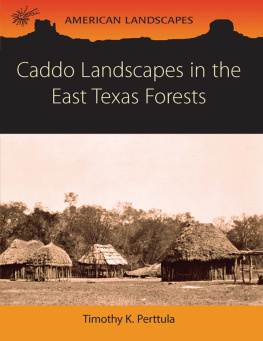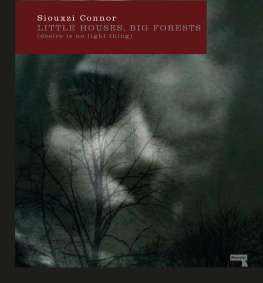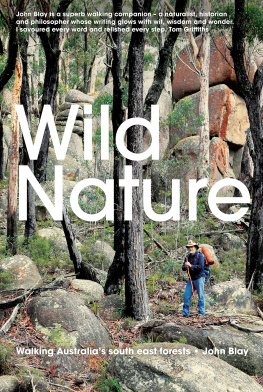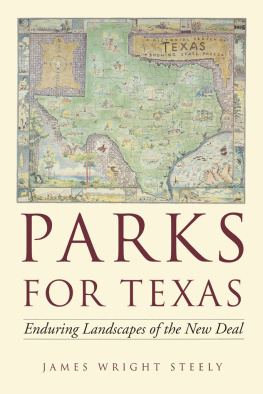Perttula Tim - Caddo Landscapes in the East Texas Forests
Here you can read online Perttula Tim - Caddo Landscapes in the East Texas Forests full text of the book (entire story) in english for free. Download pdf and epub, get meaning, cover and reviews about this ebook. year: 2017, publisher: Oxbow Books, genre: Home and family. Description of the work, (preface) as well as reviews are available. Best literature library LitArk.com created for fans of good reading and offers a wide selection of genres:
Romance novel
Science fiction
Adventure
Detective
Science
History
Home and family
Prose
Art
Politics
Computer
Non-fiction
Religion
Business
Children
Humor
Choose a favorite category and find really read worthwhile books. Enjoy immersion in the world of imagination, feel the emotions of the characters or learn something new for yourself, make an fascinating discovery.
- Book:Caddo Landscapes in the East Texas Forests
- Author:
- Publisher:Oxbow Books
- Genre:
- Year:2017
- Rating:5 / 5
- Favourites:Add to favourites
- Your mark:
- 100
- 1
- 2
- 3
- 4
- 5
Caddo Landscapes in the East Texas Forests: summary, description and annotation
We offer to read an annotation, description, summary or preface (depends on what the author of the book "Caddo Landscapes in the East Texas Forests" wrote himself). If you haven't found the necessary information about the book — write in the comments, we will try to find it.
Caddo Landscapes in the East Texas Forests — read online for free the complete book (whole text) full work
Below is the text of the book, divided by pages. System saving the place of the last page read, allows you to conveniently read the book "Caddo Landscapes in the East Texas Forests" online for free, without having to search again every time where you left off. Put a bookmark, and you can go to the page where you finished reading at any time.
Font size:
Interval:
Bookmark:

by
Timothy K. Perttula
with contributions by
Robert Cast, Ross C. Fields, and Tom Middlebrook

AMERICAN LANDSCAPES
American Landscapes is an imprint of Oxbow Books
Published in the United Kingdom in 2017 by
OXBOW BOOKS
The Old Music Hall, 106108 Cowley Road, Oxford OX4 1JE
and in the United States by
OXBOW BOOKS
1950 Lawrence Road, Havertown, PA 19083
Timothy K. Perttula 2017
Paperback Edition: ISBN 978-1-78570-576-2
Digital Edition: ISBN 978-1-78570-577-9
Mobi Edition: ISBN 978-1-78570-578-6
A CIP record for this book is available from the British Library
Library of Congress Control Number: 2017930578
All rights reserved. No part of this book may be reproduced or transmitted in any form or by any means, electronic or mechanical including photocopying, recording or by any information storage and retrieval system, without permission from the publisher in writing.
Design and layout by Frabjous Books
For a complete list of titles, please contact:
| UNITED KINGDOM | UNITED STATES OF AMERICA |
| Oxbow Books | Oxbow Books |
| Telephone (01865) 241249 | Telephone (800) 791-9354 |
| Fax (01865) 794449 | Fax (610) 853-9146 |
| Email: | Email: |
| www.oxbowbooks.com | www.casemateacademic.com/oxbow |
Oxbow Books is part of the Casemate Group
Front cover: Will Soules c . 18691875 photograph of Long Hats Camp in western Oklahoma
There are a number of people that I would like to thank for help with this book, but also for their help down the years in working with me on a variety of East Texas Caddo archaeological projects. Foremost among them have been Rodney Bo Nelson, Mark Walters, Bob D. Skiles, Linda W. Ellis, and Diane Wilson, as well as Robert Z. Selden, Jr., Chet Walker, Clay Schultz, Shawn Marceaux, Duncan McKinnon and Patti Haskins, but there are too many others to mention individually. I also want to thank the individual contributors to this book: Robert Cast (the Caddo Nations Tribal Historic Preservation Officer for many years), Ross C. Fields (Prewitt and Associates, Inc.), and Tom Middlebrook (Texas Archeological Steward in Nacogdoches, Texas).
Most of the figures and maps in this book have been prepared by Sandra L. Hannum and Lance Trask. I could not have done this book without their help.
The folks at Oxbow Books have been most gracious and helpful during the book preparation and editing process. I particularly want to thank Julie Gardiner and Pete Topping for the opportunity to write this book.
I also want to thank Mark J. Lynott, who tragically died about a month after he asked me to consider writing this book for the American Landscapes series. I first met Mark and worked with him in Texas many years ago, and then worked with him again a few years later with the National Park Service. The memory of his years as an archaeologist, and his excellent 2014 book on Hopewell Landscapes, spurred me on to complete the book.
My interest in Caddo archaeology was first fostered by Jeff Richner back in the days (1975) when I was working on the Tennessee Colony Lake project for Southern Methodist University. But it was not until I met Dr Alex D. Krieger and Robert C. Dunnell at the University of Washington and Dr Dee Ann Story at the University of Texas at Austin that my long-term research concern with Caddo archaeology really solidified and grew. I am ever appreciative of the time these scholars spent with me while I got on my feet as an archaeologist.
I am also appreciative of the advice, counsel, and support I have received over the years from the Caddo peoples themselves, including past tribal chairmen and chairwomen and Tribal Historic Preservation Office staff, as we have worked on numerous Historic Preservation Fund and Native American Graves Protection and Repatriation grants. In particular, I would like to extend my thanks to LaRue Parker, Brenda Edwards, Cecile Carter, Stacy Halfmoon and Bobby Gonzalez, as well as Robert Cast for those opportunities. I also want to thank Jeri Redcorn and Chase Earles for their support of my work, and for their years spent learning to make, and then excel at making, extraordinary Caddo pottery in traditional ways.
The Lives of Things (Jose Saramago 2012)
This book concerns the cultural and social landscape of the Caddo Indian peoples ( hayaanuh ) and their ancestors that lived in the forests of East Texas from the 9th to the 19th century AD. By cultural and social landscape, I am referring to the various elements of an ancestral Caddo constructed landscape, including earthen monuments or mounds, specialized non-mound structures, domestic settlements and their key facilities including residential structures, arbors, ramadas and outdoor activity areas as well as associated gardens and fields ( nahtuh ) for the cultivation of corn ( kisi? : Caddo words in italics throughout the text are from Kiwat Hasinay Foundation [2001]), beans ( dabas ) and squash, along with trails, and places where salt ( widish ), clay, lithic raw materials, or other materials were collected by Caddo peoples, and the social ties that linked the people together in numerous ways. These places are marked by things, the artifacts and features of the archaeological record that have been studied by archaeologists since the late 1800s to better understand the native history of Caddo communities and groups. In essence, the Caddo peoples living in East Texas constructed a long-lived historical landscape that was tied to specific places, including community centers marked by earthen mounds and/or community cemeteries, specific social organizations and different traditions/practices. Such landscapes were created by the intersection of particular cultural practices, resources, economies and environmental settings and the agency of individuals as they lived their lives (Glowacki 2015: 134).
From the long-term study of the Caddo archaeological record, it is known that this cultural and social landscape existed in East Texas for about 1000 years, and there were continual changes through time in the character and extent of ancestral Caddo landscapes, through times of plenty, risk and hardship, as well as in relationships between different communities of Caddo peoples dispersed or concentrated across the landscape at various points in time. These ancestral Caddo peoples, in all their diversity of origins, material culture, subsistence and rituals and religious beliefs, actively created their societies by establishing places on the land that became home, places where peoples living in individual homesteads and communities across the landscape were dependent upon each other and communicated with each other, leading to the formation of social networks across environments with a diverse mosaic of resources. Established places likely lent order to the chaotic worlds of people and nature, and they embodied history and the cosmos here on earth.
Caddo Social and Political Structure
The Caddo peoples have a matrilineal society, tracing descent through the maternal line rather than the paternal. This is also reflected in the kinship terms used by the Caddo, where the father and fathers brothers are called by the same term as the mother and the mothers sister. The Caddo populations were organized into lineages headed by the senior women in the community (Swanton 1942).
Next pageFont size:
Interval:
Bookmark:
Similar books «Caddo Landscapes in the East Texas Forests»
Look at similar books to Caddo Landscapes in the East Texas Forests. We have selected literature similar in name and meaning in the hope of providing readers with more options to find new, interesting, not yet read works.
Discussion, reviews of the book Caddo Landscapes in the East Texas Forests and just readers' own opinions. Leave your comments, write what you think about the work, its meaning or the main characters. Specify what exactly you liked and what you didn't like, and why you think so.







